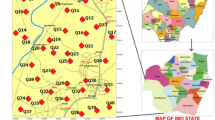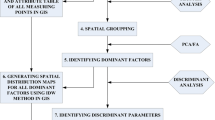Abstract
Mine tailings generate significant environmental impacts and contribute to water pollution. The Central Rand goldfield, South Africa is replete with gold mine tailings which have contributed significantly to water pollution as a result of acid mine drainage (AMD). Water quality is affected by mine tailings and spillages, especially from active slimes dams, currently reprocessed tailings, as well as footprints left behind after reprocessing. The release and distribution of uranium from these sites was studied. Correlation matrices show a strong link between different variables as a result of AMD produced. Principal component analysis (PCA) was used to identify very influential variables which account for the pollution trends. Artificial neural networks (ANN) using the Kohonen algorithm were applied to visualise these trends and patterns in the distribution of uranium. High concentrations of this radionuclide were detected in streams in the vicinity of the tailings dumps, active slimes and reprocessing areas. The concentrations are reduced drastically in dams and wetlands as a result of precipitation and dilution effects.
Similar content being viewed by others
References
M.J. Viljoen and W.U. Reimold, An introduction to SA’s geological and mining heritage, Geological Society of South Africa and Mintek (1999) pp. 37–39.
D.W. Blowes, C.J. Ptacek, S.G. Benner, K.R. Waybrant and J.G. Bain, Permeable reactive barriers for the treatment of mine tailings drainage water, in: Proceedings of the International Conference and Workshop on Uranium Mining and Hydrogeology, September 1998, Freiberg, Germany, Vol. 2, pp. 113–119.
T. Rosner, R. Boer, R. Reyneke, P. Aucamp and J. Vermaak, A preliminary assessment of pollution contained in the unsaturated and saturated zone beneath reclaimed gold-mine residue deposits, Water Research Commission Report No 797/1/01.
R. Finch and T. Murakami, Geochemistry and the Environment 38 (1991) 91–179.
G. Meinrath, J. Radioanal. Nucl. Chem. 232 (1998) 179.
J. Selbin and J.D. Ortego, Chem. Rev. 69 (1969) 657.
D. Langmuir, Uranium solution-mineral equilibria at low temperatures with applications to sedimentary ore deposits, Geochemica et Cosmochica Acta 42 (1978) 547–569.
A.C. Miller, W.F. Blakely, V. Livengood, T. Whittaker, J. Xu, W.J. Ejnik, M.M. Hamilton, E. Parlette, T.S. John, H.M. Gerstenberg and H. Hsu Transfomation of human osteoblast to tumorigenic phenotype by depleted uranium-uranyl chloride, Environ. Health Perspec. 106 (1998) 465–471.
J. Patočka, J. Kassa, R. Štětina, G. Šafr and J. Havel, Toxicological aspects of depleted uranium, J. Appl. Biomed. 2 (2004) 37–42.
WHO, Guidelines for Drinking Water Quality, Vols 1 and 2, 2nd edn (WHO, Geneva, Switzerland, 1993).
G. Bernhard, G. Geipel, V. Brendler and H. Nitsche, Uranium speciation in waters of different uranium mining areas, J. Alloys and Compounds 271–273 (1998) 201–205.
K. Naicker, E. Cukrowska and T.S. McCarthy, Acid mine drainage arising from gold mining activity in Johanneburg, South and environs, J. Env. Pollution 122 (2003) 29–40.
T. Rosner and A. van Schalkwyk, The environmental impact of gold mine tailings footprints in the Johannesburg region, South Africa, Bull. Eng. Geol. Env. 59 (2000) 137–148.
H. Coetzee, Airborne radiometric mapping of the environmental impact of gold and uranium mining in the Gauteng Province, South Africa, in: Proceedings: Symposium on the Application of Geophysics to Environmental and Engineering Problems, April, Orlando, Florida, USA (1995).
H. Coetzee, Radioactivity and the leakage of radioactive waste associated with Witwatersrand gold and uranium mining, in: Proceedings: International Conference and Workshop on Uranium Mining and Hydrogeology, October, Freiberg, Germany (1995).
http://www.personal.rdg.ac.uk/~shsmchlr/nnets/nnkohonen.pdf+kohonen.
http://www.willamette.edu/~gorr/classes/cs449/Unsupervised/SOM.html.
http://www.shef.ac.uk/psychology/gurney/notes/17/subsection3_3_2.html.
A.F. Batisha, Pollution detection in environmental systems based on feature-sensitive neural networks, in: Proceedings: International Conference on Integrated Management of Water Resources in the 21st Century, Cairo, Egypt (1999).
J.M. Ehrman, T.A. Clair and A. Bouchard, Using neural networks to predict changes in acidified eastern Canadian lakes, AI Applications 10(2) (1996).
R.M. Singh, B. Datta and A. Jain, Identification of unknown ground water pollution sources using artificial neural networks, Journal of Water Resources Planning and Management 130(6) (2004) 506–514.
J.P. Suen and J.W. Eheart, Evaluation of neural networks for modelling nitrate concentrations in rivers, Journal of Water Resources Planning and Management 129(6) (2003) 505–510.
D.A. Pretorius, The Geology of Some ore Deposits in Southern Africa, Vol. 1 (Geological Society of South Africa, Johannesburg, 1964) pp. 63–108.
R. Scott, Flooding of Central and East Rand gold mines: An investigation into controls over the inflow rate, water quality and the predicted impacts of flooded mines, Water Research Commission, Report No. 224/1/72, 238.
H.F. Hermond and E.J. Fechner-Levy, Chemical Fate and Transport in the Environment (Academic Press, San Diego, 2000).
J.E. Jackson, A User’s Guide to Principal Component Analysis (Wiley-Interscience, New York, 1991).
N.F. Mphephu, Geotechnical evalution of environmental impacts of mining activities in the Central Rand, PhD Thesis, University of the Witwatersrand, South Africa (2003).
H. Tutu, E.M. Cukrowska, T.S. McCarthy, N.F. Mphephu and R. Hart, Determination and modelling of geochemical speciation of uranium in gold mine polluted land in South Africa, in: Proceedings: International Congress on Mine Water and the Environment, Johannesburg, South Africa (2003) pp. 137–155.
N.F. Mphephu, M.J. Viljoen, H. Tutu, E. Cukrowska and K. Govender, Mineralogy and geochemistry of mine tailings in relation to water pollution on the Central Rand, South Africa, in: Proceedings: Conference on Environmental Issues and Waste Management in Energy and Mineral Production, Antalya, Turkey (2004) pp. 445–449.
Author information
Authors and Affiliations
Rights and permissions
About this article
Cite this article
Tutu, H., Cukrowska, E.M., Dohnal, V. et al. Application of artificial neural networks for classification of uranium distribution in the Central Rand goldfield, South Africa. Environ Model Assess 10, 143–152 (2005). https://doi.org/10.1007/s10666-005-0214-x
Received:
Accepted:
Issue Date:
DOI: https://doi.org/10.1007/s10666-005-0214-x




